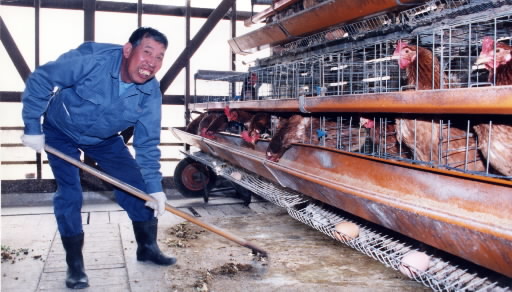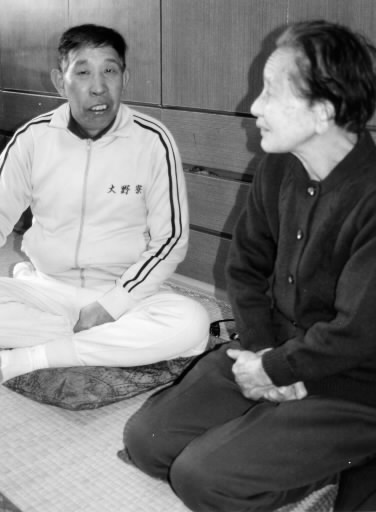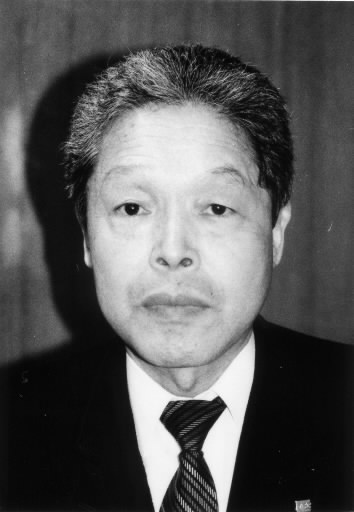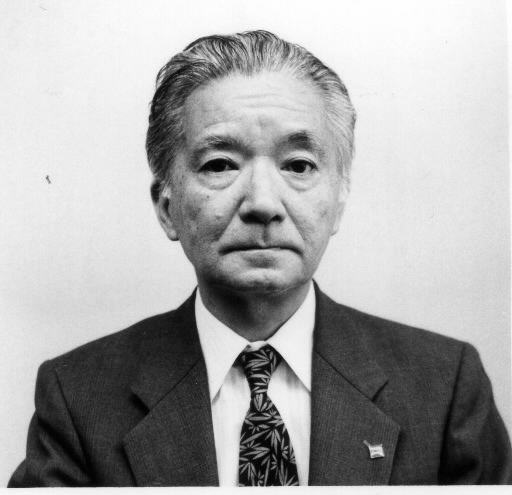History of Hiroshima: 1945-1995 (Part 9, Article 1)
Aug. 1, 2012
A-bomb microcephaly
by Masuhei Ona, Senior Staff Writer
Note: This article was originally published in 1995.
Microcephaly patients born with disabilities, including mental disabilities, after being exposed to the atomic bomb while in their mothers’ wombs... Old, lonely A-bomb survivors forced to live their lives in isolation because of the bomb... Even now, 50 years after the city of Hiroshima was attacked, the bodies of such people continue to prompt questions about the sinfulness of the bombing and the suffering it wrought.
Are the welfare facilities set up by the government really sufficient for the A-bombed elderly and the mentally disabled? The Chugoku Shimbun paid visits to a microcephaly patient and a lonely A-bomb survivor who have lived alongside people enduring similar plights for the past 25 years at their respective facilities.
Currently, the Ministry of Health and Welfare holds a list of 24 people who have been registered as microcephaly patients. Meanwhile, the situation involving aging A-bomb survivors has changed with the passing of time and a new class of survivors, though they still have family, are nevertheless facing a “psychological isolation.”
Cruelty of fate lingers on in microcephalic patients
Ohno Station, located in Ohno-cho, a town in Hiroshima Prefecture, lies on the JR Sanyo Line. On the first Sunday morning of each month, a group of soberly-dressed men and women in their 60s and 70s gather in the waiting room of the small station. Most already appear to be acquainted and they greet one another in low voices.
These are the parents of those who live at the Ohno Dormitory, a prefecture-run vocational facility for the mentally disabled that sits about 7 kilometers from the station. Every month, on this day, the parents are permitted to meet with their children. Though they are “children” to their parents, the average age of the people residing in the dormitory is 45. In the aging faces of the parents can be seen their concern for the future.
Yoshiko Kamura, 79, a resident of Naka Ward, Hiroshima, is one such parent. Her second son Haruo, 49, who was exposed to the atomic bomb while in his mother’s womb, has lived in the dormitory since June 1967, 28 years ago. Ever since, barring emergency, Ms. Kamura has come every single month to visit her son.
“We don’t talk about anything special, really, but I feel so sorry for him when I hear that he waits at the gates for a long time when I don’t go,” Ms. Kamura said. In her eyes, Haruo will always be a child to worry over, no matter how old he grows.
Haruo was born in February 1946, seven months after the bomb was dropped. It was an easy birth and did not require the help of a midwife. “He was a tiny child, only about 1,100 grams, and he fit into my cupped hands like a kitten,” Ms. Kamura recalled.
It never occurred to her that her baby had suffered the impact of the A-bomb’s radiation and was born burdened with microcephaly, which produces mental retardation.
When the bomb exploded, Ms. Kamura was three months’ pregnant and at home in the Funairi-nakamachi district, about 1.1 kilometers from the hypocenter. Although buried under her collapsed house, she was able to crawl out and flee to the suburbs, chased by flames.
“I wasn’t really hurt in the bombing and I was quite healthy after the war,” she said. “I didn’t think my unborn baby would be affected by it.”
Because Haruo was prone to illness, he entered elementary school a year late. His condition was eventually discovered in a health checkup. After being contacted by the Atomic Bomb Casualty Commission (ABCC), Ms. Kamura brought Haruo to Hijiyama, the part of town where the research center was located. After the examination, she was told, “He will live another three or four years, at the most.”
“I couldn’t comprehend it,” Ms. Kamura said. “I just felt so sorry for Haruo and so sad about the whole thing.” It was spring and Haruo was 7 years old.
Though Haruo was able to complete elementary school, he was a sickly child. As he couldn’t keep up with his studies, he didn’t go on to junior high school, and he spent his days at home. His favorite pastimes were watching television and playing with the younger children who lived nearby.
When Haruo turned 21, he entered Ohno Dormitory at the start of that summer. “Some of the young people in the neighborhood would lure him off by saying they were going to see a fire in another part of town and then leave him there,” Ms. Kamura explained. “He would return home in tears, late at night...” After several incidents like this, and the encouragement of a friend, she decided to place Haruo into the facility.
Twenty-eight years have passed since then, and Haruo remains at Ohno Dormitory. Three times a year, during the New Year’s holiday, the consecutive holidays in May, and a week for the Bon holidays in August, he returns home for a visit. Other than that, the only times he contacts the outside world is the monthly meeting day, shopping trips to Iwakuni a few times a year, and excursions with others from the dormitory.
On February 5, Haruo met Ms. Kamura for the first time in a month and happily told her, “Mother, I received wages of 6,340 yen this month.”
At the dormitory, the residents engage in such light work as taking care of chickens, growing vegetables, and chopping wood. Wages are paid in line with the kind of work done. The aim is to foster independence in the residents and encourage their social life. The money is then saved and used during shopping trips.
These days, Haruo’s morning chore is cleaning the chicken coops. He rakes out the buildings, amasses the droppings of some 300 chickens, and wheels the pile to the compost heap. Other residents undertake the tasks of feeding the chickens and gathering their eggs.
When asked if he enjoys his work, Haruo replied with a wide smile, “Yes, it’s fun.” His interests include baseball and enka, traditional Japanese ballads. He is also a fan of the Seibu Lions baseball team and the singer Miyuki Kawanaka.
At lunchtime on February 27, a birthday party was held for the residents who have birthdays in February. Haruo, whose hair is starting to turn white, said happily, “I turned 49.”
Haruo’s future is not a cause of concern for Ms. Kamura. “They all take good care of him at the Ohno Dormitory,” she explained. “And when he grows old, they can find a nursing home for him.” Even if she eventually becomes bedridden and unable to visit the dormitory, Haruo’s older brother or younger sister will pay him visits each month.
Currently, the residents of the Ohno Dormitory consist of 30 men and 20 women. The oldest is 65 years old. Once they enter the facility, most remain there for the rest of their lives. While the head instructor, Kazunari Yamawaki, says, “As the residents have the capacity to work hard on a defined task, I wish that society would welcome them more and give them opportunities to use their abilities,” he also admits that many of them are reluctant to take up a job outside the facility.
Stepping out into society from the safe, familiar life of the dormitory involves a number of difficulties. Even with gainful employment, other daily concerns like preparing meals and handling personal finances are significant challenges. While the facility has as its mission “A life of mutual support within the home and neighborhood, rather than an isolated life within the dormitory,” the hurdles presented by reality are not easy to overcome.
On a cold winter day in February, 22 years ago, another mother who bore a child with microcephaly passed away in Hiroshima with worries about that child’s future on her mind right up to the moment of her death. She was four months’ pregnant when she experienced the atomic bomb at a location 1 kilometer from the hypocenter. A year before her death, the mother wrote about the emotions of a parent with a child affected by microcephaly in an account of her life...
“For as long as my son lives, I want him to lead the same kind of life as a normal human being. I want to die after seeing him find a wife who is healthy and will stay by his side, no matter his appearance or condition...”
But this wish has not been realized. And for Haruo, who faces a similar predicament, most of his life has also been spent behind the walls of a vocational facility.
“The Mushroom Club” lends support to patients and families
The medical world grew aware of the problem of A-bomb microcephaly from a fairly early point. However, the condition only became known to the broader public in 1965, when “Kono Sekai no Katasumi de” (“In a Corner of the World”) was issued by the Iwanami Shoten publishing company.
The book contains eight articles written by the “Hiroshima Study Group,” which was established by the author Tomoe Yamashiro and comprised of young journalists and others from Hiroshima in an attempt to reexamine the damage caused by the atomic bomb.
One of the articles in the book is called “In Utero.” The writer is Toshihiko Akinobu, an employee of the RCC Broadcasting Company who now heads RCC radio. He published his story under the pen name Koji Kazahaya. Mr. Akinobu was not involved in any A-bomb-related activities at the time he learned of the project.
“I wasn’t busy with anything else when I heard about Ms. Yamashiro’s idea, so I immediately agreed to take part,” he explained. He began to research A-bomb-related diseases, and met children affected by microcephaly.
Although the condition was familiar to the medical community, its existence was a shock to Mr. Akinobu. Moreover, in the medical literature issued by ABCC, the patients were seen as statistics, their identities obscured by false names, and such reports merely described the problem in the past tense. They showed no interest in the suffering that the patient and the patient’s family were forced to endure. Mr. Akinobu has written about his thoughts when he made this discovery:
“If these children suffering from microcephaly are now living somewhere in Hiroshima and Nagasaki, 20 years after the atomic bombs were dropped, then this is a reality that must not be dismissed as a trivial matter.” Mr. Akinobu investigated the false names found in the medical reports and discovered the identities of seven microcephalic patients. He then reported on the lives of each one.
The efforts of the “Hiroshima Study Group” did not end with their reporting activities, though. Moved by the words of a parent of one of the microcephalic patients, who said, “All of you will be done with this problem after your book is published, but we have to live with our children for the rest of our lives,” the members of the study group concluded: “If we abandon this issue after publishing the book, we’ll be no different from those who simply reported on past cases of microcephaly.”
One month before the book was issued, the members of the “Hiroshima Study Group” helped establish “The Mushroom Club,” a club for microcephalic patients and their families. Since then, this club has pursued such support activities as nurturing ties between the parents of microcephalic patients, who had tended to become isolated from the rest of society, as well as lobbying the government to implement special measures for those affected by this condition.
But after 30 years, “The Mushroom Club” is facing a turning point. Many of the parents are no longer able to take part actively due to advancing age, and some have passed away. Caretakers have stepped in, but tending to the needs of microcephalic patients is an enormous challenge.
Minoru Omuta, the chairman of the Hiroshima Peace Culture Foundation and the representative of the caretakers, comments: “When the parents are gone, there is only so much that an outsider can do.” It is next to impossible for a few well-meaning caretakers to provide full support to the lives of patients who suffer from mental disabilities of this kind.
Because of this, “The Mushroom Club” hopes to increase its membership by evolving into the “Association to Support Patients with Microcephaly” in conjunction with the “50th birthday party” for the patients that will be held in June of this year.
(Originally published on March 19, 1995)











